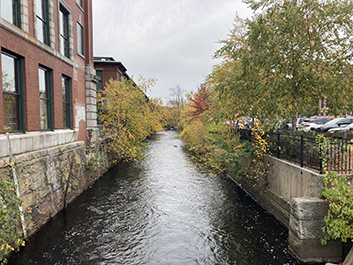
Lawrence and Methuen Unite to Improve Water Quality in the Spicket River.
By Tennis Lilly, Groundwork Lawrence
A Watershed-Based Plan is in the final stages of development to identify and address pollution impacting the health of the Spicket River. The cities of Lawrence and Methuen have worked with the Merrimack River Watershed Council to determine how Phosphorus and bacteria are negatively impacting the health of the river. Groundwork Lawrence and the Merrimack Valley Planning Commission are supporting the development of the plan.
Water quality data was collected over the past twelve months at eleven locations along the Spicket River and the Bloody Brook, a tributary of the Spicket located in Lawrence and Methuen. The results show that 40% of the sampling sites experience elevated levels of bacteria and phosphorus.
These results are consistent with results from other suburban and urban communities where there is a lot of impervious cover—land surfaces such as paved roads, parking lots, and roofs that prevent the infiltration of water into the ground. The data shows that there is a strong link between impervious land cover and stream water quality, as impervious surfaces contribute to higher stormwater runoff volumes and transport pollutants with great efficiency.
The source of bacteria and Phosphorus pollution in the Spicket River is often referred to as “non-point source” pollution, meaning the pollution doesn’t come from a specific source, such as a pipe at a sewage treatment plant or a factory. Non-point pollution sources can include pet waste, runoff from car washing, and excessive fertilizer on lawns, among others.
A principal component of this Watershed-Based Plan is a list of land parcels where Green Stormwater Infrastructure can be constructed to better manage this runoff flowing into the Spicket River. These nature-based solutions help to lower runoff volumes and allow stormwater to infiltrate into the ground, rather than being conveyed into a pipe that discharges into a river, which also helps flood mitigation.
Completing the Spicket River Watershed-based Plan will make the communities of Lawrence and Methuen eligible to apply for state and federal funding to build Green Stormwater Infrastructure.
From the beginning, community input to understand residents’ perceptions of the Spicket River to help aid in the development of this Watershed-Based Plan. A stakeholder survey implemented during the planning process showed most respondents gave the river and greenway high marks for their appearance but had concerns about floating trash in the river, Combined Sewer Outflows (CSOs), and water quality.
In addition to gathering survey results from stakeholders, a 6-member community advisory panel was created to review the Watershed-Based Plan, provide additional input, and advise the partners on the planning and installation of nature-based stormwater infrastructure to improve water quality.
The 18-mile-long Spicket River flows from Big Island Pond in Atkinson, NH through the towns of Hampstead, Derry, and Salem, New Hampshire before crossing into Massachusetts, where it makes its way through Methuen and Lawrence and empties into Merrimack River.
Next month, residents will have a chance to learn more about the plan and offer their feedback at two community meetings. These meetings will be held at 7:00 PM on Tuesday, December 5th at the Nevins Library Methuen, and 7:00 PM on Wednesday, December 6th at the Lawrence Public Library. Anyone interested in learning more about the Spicket River Watershed-Based Plan is encouraged to attend.


Be the first to comment